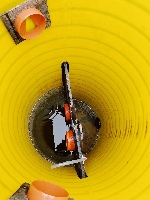Authors: Rūta Abaja, Ieva Mežaka, Institute for Environmental Solutions
The agricultural sector will face many challenges, that are related to climate change - changes in weather patterns, air temperatures and water cycle balances. At the same time, demand for agricultural products is rising in line with the world's growing global population. One of the methods recommended worldwide for more efficient use of water and dissolved nutrients in agricultural land is controlled drainage (CD). Within the LIFE CRAFT (LIFE16 CCM/LV/000083) project in Latvia, in Smiltene and Meņģele parishes, two pilot areas tested the suitability of CD in fields as one of the potential climate change mitigation practices in agriculture. The results of the project confirm the world-recognised usefulness of CD in reducing drought risks and nutrient outputs (especially nitrogen and phosphorus compounds). However, the reduction of carbon dioxide emissions and dinitrogen oxide and methane accumulation were only partially observed in the mineral soil areas of the project installed with CD. The mixed results from greenhouse gas (GHG) monitoring are due to heterogeneous soil and surface topography conditions. The functioning of the existing land amelioration system varied between the pilot areas and it was not possible to accurately adjust the same level of water retention after the construction of the CD. These conditions prevented a clear distinction of GHG changes between CD and traditional land amelioration system areas in the CD demonstration pilot areas.
A follow-up article will be available in a handbook on climate-friendly agricultural practices.
